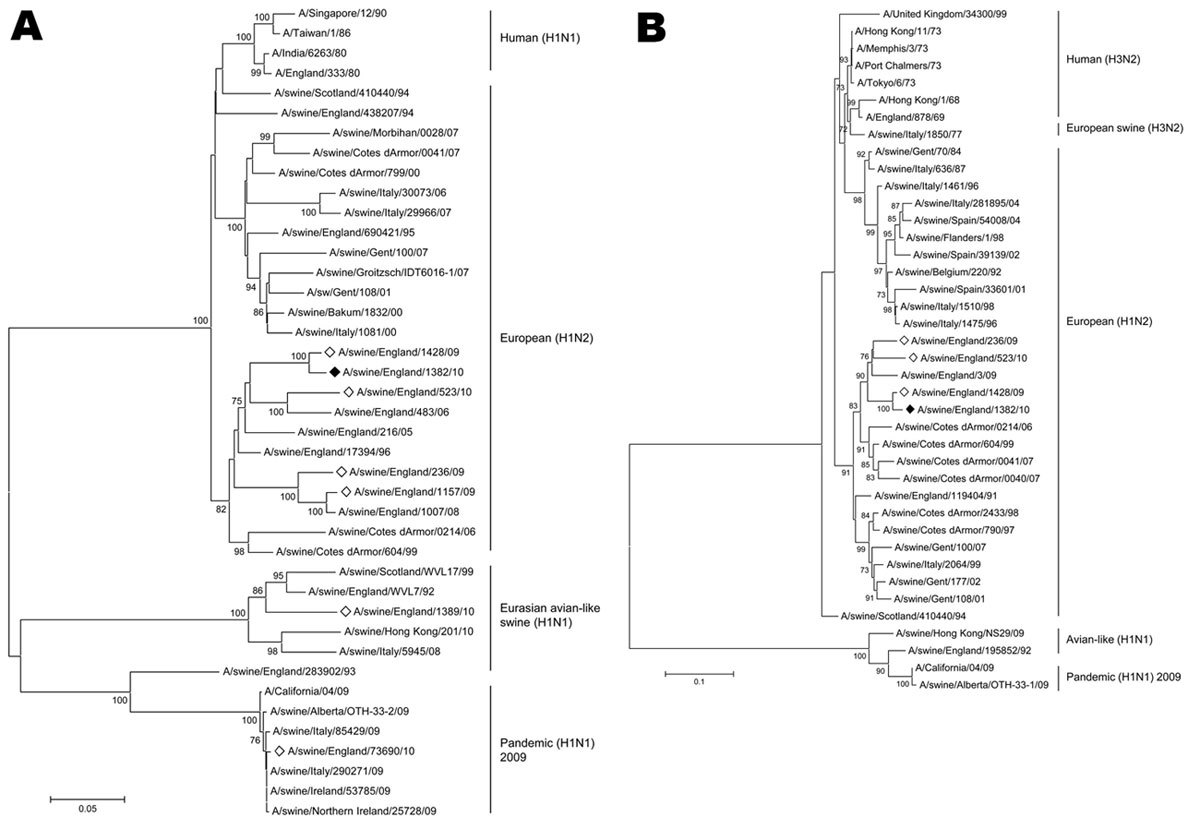Volume 17, Number 6—June 2011
Dispatch
Reassortant Pandemic (H1N1) 2009 Virus in Pigs, United Kingdom
Figure

Figure. Phylogenetic analysis of influenza A virus hemagglutinin (A) and neuraminidase (B) genes. Trees were constructed by using the neighbor-joining method. Solid diamonds indicate A/swine/England/1382/10 genes from virus isolated in this study, and open diamonds indicate genes from other viruses reported in this study. Percentage of replicate trees in which the associated taxa clustered together in the bootstrap test (1,000 replicates) is shown next to the branches for values >70% (11). Evolutionary distances were computed by using the Tamura-Nei method (12). Phylogenetic analyses were conducted by using MEGA4 (13). Scale bars indicate nucleotide substitutions per site.
References
- Taubenberger JK, Reid AH, Janczewski TA, Fanning TG. Integrating historical, clinical and molecular genetic data in order to explain the origin and virulence of the 1918 Spanish influenza virus. Philos Trans R Soc Lond B Biol Sci. 2001;356:1829–39. DOIPubMedGoogle Scholar
- Shope RE. Swine influenza: III. Filtration experiments and etiology. J Exp Med. 1931;54:373–85. DOIPubMedGoogle Scholar
- Van Reeth K, Brown IH, Durrwald R, Foni E, Labarque G, Lenihan P, Seroprevalence of H1N1, H3N2 and H1N2 influenza viruses in pigs in seven European countries in 2002–2003. Influenza Other Respir Viruses. 2008;2:99–105. DOIPubMedGoogle Scholar
- Brown IH, Chakraverty P, Harris PA, Alexander DJ. Disease outbreaks in pigs in Great Britain due to an influenza A virus of H1N2 subtype. Vet Rec. 1995;136:328–9. DOIPubMedGoogle Scholar
- Brown IH, Harris PA, McCauley JW, Alexander DJ. Multiple genetic reassortment of avian and human influenza A viruses in European pigs, resulting in the emergence of an H1N2 virus of novel genotype. J Gen Virol. 1998;79:2947–55.PubMedGoogle Scholar
- Brown IH. The role of pigs in interspecies transmission. In: Klenk H-D, Matrosovich MN, Stech J, editors. Avian influenza. Monographs in virology. Vol. 27. Basel (Switzerland): Karger; 2008. p. 88–100.
- Garten RJ, Davis CT, Russell CA, Shu B, Lindstrom S, Balish A, Antigenic and genetic characteristics of swine-origin 2009 A(H1N1) influenza viruses circulating in humans. Science. 2009;325:197–201. DOIPubMedGoogle Scholar
- Vijaykrishna D, Poon LL, Zhu HC, Ma SK, Li OT, Cheung CL, Reassortment of pandemic H1N1/2009 influenza A virus in swine. Science. 2010;328:1529. DOIPubMedGoogle Scholar
- Slomka MJ, Densham AL, Coward VJ, Essen S, Brookes SM, Irvine RM, Real time reverse transcription (RRT)-polymerase chain reaction (PCR) methods for detection of pandemic (H1N1) 2009 influenza virus and European swine influenza A virus infections in pigs. Influenza Other Respir Viruses. 2010;4:277–93. DOIPubMedGoogle Scholar
- World Organisation for Animal Health. Swine influenza. Manual of diagnostic tests and vaccines for terrestrial animals. 6th ed. Paris: The Organisation; 2008 [cited 2011 Mar 8]. http://www.oie.int/eng/normes/mmanual/2008/pdf/2.08.08_SWINE_INFLUENZA.pdf
- Felsenstein J. Confidence limits on phylogenies: an approach using the bootstrap. Evolution. 1985;39:783–91. DOIGoogle Scholar
- Tamura K, Nei M. Estimation of the number of nucleotide substitutions in the control region of mitochondrial DNA in humans and chimpanzees. Mol Biol Evol. 1993;10:512–26.PubMedGoogle Scholar
- Tamura K, Dudley J, Nei M, Kumar S. MEGA4: Molecular Evolutionary Genetics Analysis (MEGA) software version 4.0. Mol Biol Evol. 2007;24:1596–9. DOIPubMedGoogle Scholar
- Yamada S, Hatta M, Staker BL, Watanabe S, Imai M, Shinya K, Biological and structural characterization of a host-adapting amino acid in influenza virus. PLoS Pathog. 2010;6:pii:e1001034.
- Kyriakis CS, Olsen CW, Carman S, Brown IH, Brookes SM, Doorsselaere JV, Serologic cross-reactivity with pandemic (H1N1) 2009 virus in pigs, Europe. Emerg Infect Dis. 2010;16:96–9. DOIPubMedGoogle Scholar
Page created: August 04, 2011
Page updated: August 04, 2011
Page reviewed: August 04, 2011
The conclusions, findings, and opinions expressed by authors contributing to this journal do not necessarily reflect the official position of the U.S. Department of Health and Human Services, the Public Health Service, the Centers for Disease Control and Prevention, or the authors' affiliated institutions. Use of trade names is for identification only and does not imply endorsement by any of the groups named above.